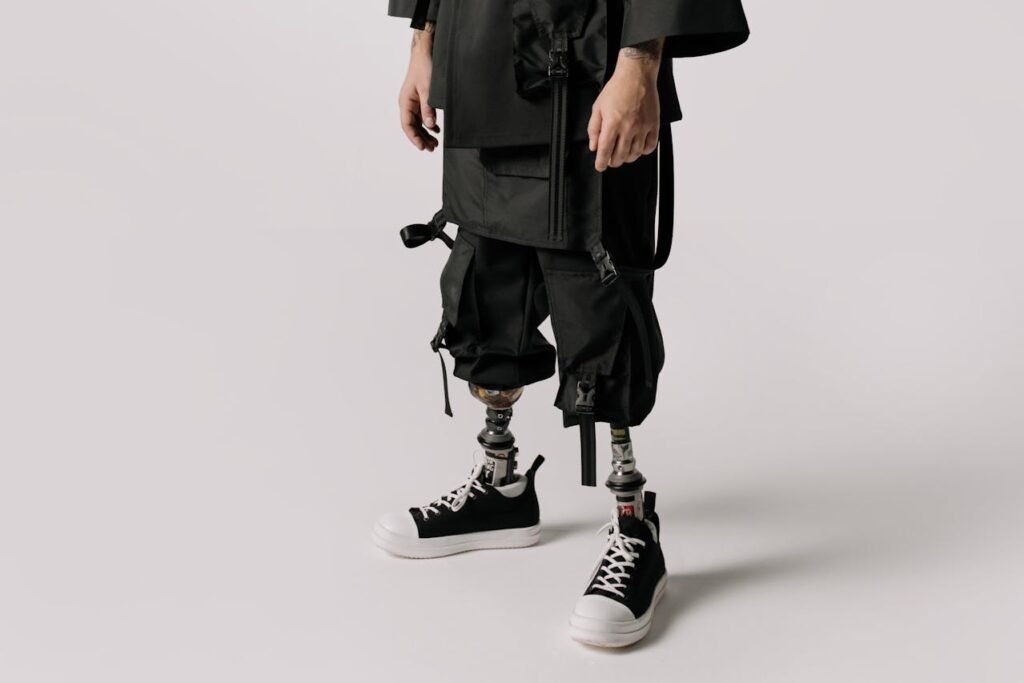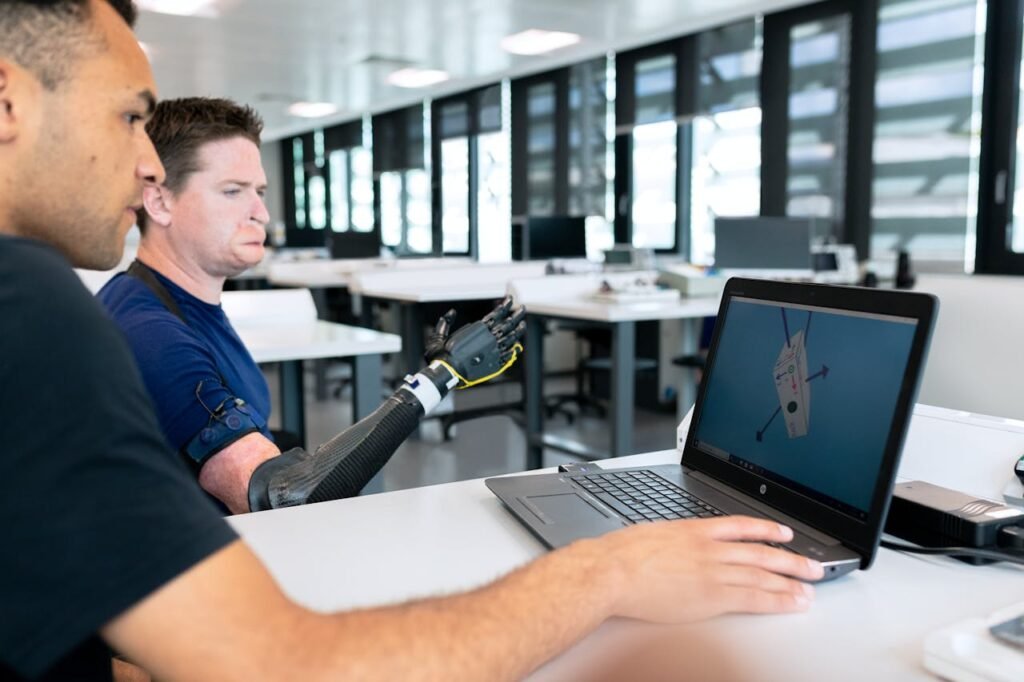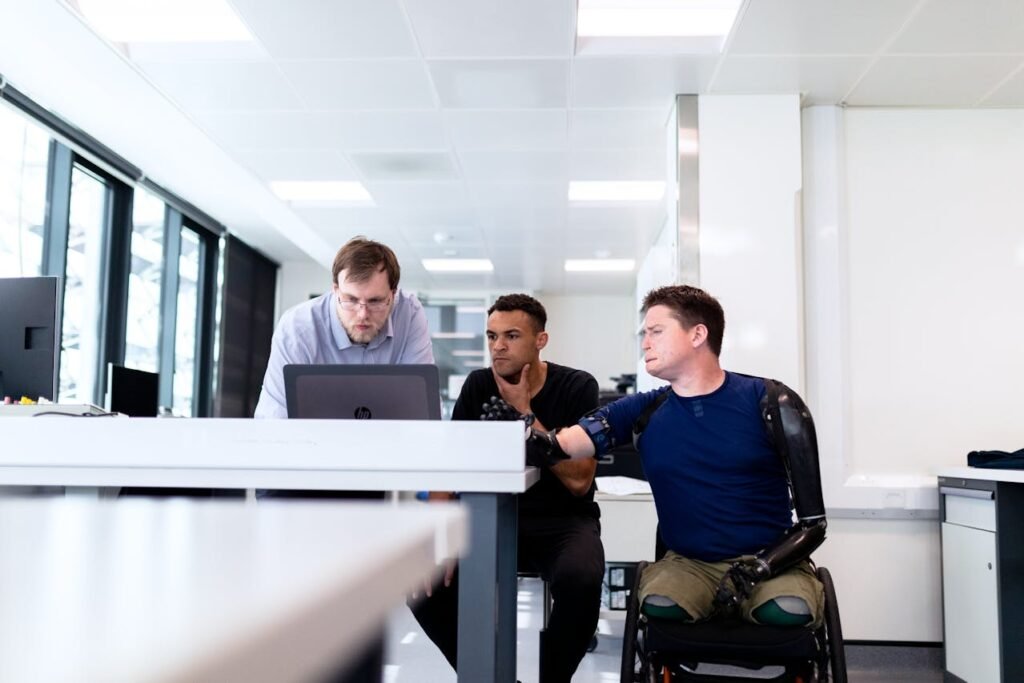Losing a limb is a life-changing experience, and choosing the right prosthetic device is an important step in reclaiming mobility and independence. Among the options available, above-knee (AK) and below-knee (BK) prosthetics are two distinct types, each designed to address specific needs and challenges. But how do you determine which one is right for you?
Your choice depends on several factors, including the level of amputation, your lifestyle, and your personal goals. Understanding the differences between these prosthetic types, their components, and their capabilities can help you make an informed decision that aligns with your needs. At Robobionics, we’re here to guide you through this process, ensuring that your prosthetic solution enhances not just your mobility but your overall quality of life.
Understanding Above-Knee (AK) and Below-Knee (BK) Prosthetics
Before diving into specifics, it’s important to understand what differentiates above-knee prosthetics from below-knee prosthetics. The distinction lies in the level of amputation and, consequently, the complexity of the prosthetic design and functionality.
Above-Knee Prosthetics
Above-knee prosthetics are designed for individuals whose amputation occurs above the knee joint. These devices must replace both the knee and the lower leg, making them more complex in terms of mechanics and control.
The addition of an artificial knee joint introduces unique challenges and opportunities for users, particularly in achieving stability and natural movement.
Advanced AK prosthetics often include microprocessor-controlled knees that adapt to walking speed and terrain, offering users a more intuitive experience.
While these devices provide incredible functionality, they require greater energy expenditure compared to BK prosthetics, as the user must control both the prosthetic knee and foot.
Below-Knee Prosthetics
Below-knee prosthetics are used by individuals whose amputation occurs below the knee joint. These devices preserve the natural knee, allowing for more efficient and natural movement.
Because the knee joint remains intact, BK prosthetics typically require less energy to operate and are easier to adapt to during rehabilitation.
BK prosthetics often focus on providing a comfortable socket and responsive foot design to enhance mobility and balance.
While they are generally less complex than AK prosthetics, advanced BK devices can incorporate dynamic ankle and foot components for improved functionality on uneven terrain.

Comparing Functional Differences
The choice between an above-knee and below-knee prosthetic largely depends on the functional needs of the user. While both aim to restore mobility, their mechanics, energy demands, and customization options vary significantly.
Energy Efficiency and Movement
One of the key considerations is the amount of energy required for movement. AK prosthetics demand more effort because the user must manage the artificial knee joint in addition to the foot.
For individuals with high activity levels or demanding lifestyles, this can present a challenge, particularly during long walks or climbing stairs.
In contrast, BK prosthetics allow users to leverage their natural knee joint, resulting in a more energy-efficient gait. This makes them a preferred choice for individuals who prioritize endurance and ease of movement in their daily routines.
Adaptability to Terrain
Advanced prosthetics are equipped to handle various terrains, but the level of control differs between AK and BK designs.
Modern AK prosthetics often include features like stance control and swing-phase adjustments, which help users navigate uneven surfaces with confidence. However, mastering these features requires time and practice.
BK prosthetics, by preserving the natural knee’s adaptability, generally provide better balance and stability on uneven ground. For users who frequently engage in outdoor activities or work in environments with unpredictable terrain, this can be a critical advantage.
Comfort and Fit: A Critical Consideration
The fit and comfort of a prosthetic limb significantly influence its usability and the user’s overall satisfaction. Both above-knee (AK) and below-knee (BK) prosthetics have unique challenges and solutions when it comes to achieving a proper fit and ensuring long-term comfort.
Above-Knee Prosthetics: Addressing the Socket Fit
For AK prosthetics, the socket—the part of the prosthetic that fits over the residual limb—is one of the most important components. The socket must provide a secure fit without causing discomfort or restricting blood flow.
Because AK prosthetics involve longer residual limbs and higher levels of motion, the fit must accommodate a range of movements while maintaining stability.

Innovations in socket design, such as suction suspension systems and flexible materials, have improved comfort significantly. These advancements reduce skin irritation and allow for better weight distribution.
However, the complexity of fitting an AK prosthetic often requires multiple fittings and adjustments, making the initial adaptation process longer.
At Robobionics, we emphasize precision in socket design, ensuring that each prosthetic is tailored to the user’s anatomy for maximum comfort and functionality.
Below-Knee Prosthetics: Simpler Fit, Equal Importance
For BK prosthetics, the socket fit is generally less complex because it interfaces with a shorter residual limb and does not involve the knee joint. This allows for more straightforward suspension systems, such as silicone liners or vacuum-assisted suspension.
Despite the simpler fitting process, the comfort of BK prosthetics is equally important. An ill-fitting socket can lead to pressure sores, discomfort, and even rejection of the prosthetic. Properly designed BK sockets distribute weight evenly and allow for flexibility during activities like running or climbing stairs.
Users of both AK and BK prosthetics benefit from ongoing support and adjustments to ensure their prosthetic remains comfortable over time. Factors such as changes in body weight or residual limb size can affect fit, highlighting the importance of regular check-ups and maintenance.
Cost Considerations: Budget vs. Benefits
The financial aspect of selecting a prosthetic limb is often a key consideration for users. The cost of AK and BK prosthetics varies widely, influenced by the level of technology, materials, and customization required.
Above-Knee Prosthetics: Higher Complexity, Higher Cost
AK prosthetics tend to be more expensive due to their complexity. The inclusion of an artificial knee joint, often powered by advanced microprocessors, adds to both the functionality and the price of the device.
Users who opt for features like computerized knee control, dynamic alignment, or waterproof components may face a higher initial cost.
However, these features can significantly enhance quality of life by providing greater freedom of movement and reducing the physical strain of using the prosthetic. For businesses, offering flexible payment plans or insurance assistance can make these devices more accessible to a wider audience.
Below-Knee Prosthetics: Cost-Effective and Versatile
BK prosthetics are generally more affordable than their AK counterparts, making them a popular choice for individuals with limited budgets. Their simpler design reduces manufacturing costs without compromising on functionality.
Advanced BK prosthetics, featuring energy-return feet or adjustable ankle joints, offer high performance at a fraction of the cost of comparable AK systems.
For businesses, focusing on cost-effective production methods—such as modular designs or 3D printing—can further enhance the affordability of BK prosthetics. Highlighting these features in marketing efforts can appeal to budget-conscious users while showcasing the device’s value.
Rehabilitation and Adaptation: The Path to Mobility
Adapting to a prosthetic limb involves more than selecting the right device. Rehabilitation plays a critical role in helping users regain confidence, develop new skills, and integrate their prosthetics into daily life. The rehabilitation process varies for above-knee (AK) and below-knee (BK) prosthetics, reflecting the unique challenges and opportunities of each type.
Above-Knee Prosthetics: Building Strength and Coordination
The use of an AK prosthetic requires users to develop greater strength and coordination compared to BK prosthetics. This is because controlling an artificial knee joint involves mastering balance, timing, and gait mechanics.
Rehabilitation programs for AK users often emphasize muscle strengthening exercises for the hip and core, which are essential for stabilizing the prosthetic during movement.
Learning to use advanced features, such as microprocessor-controlled knees, also forms a key part of the adaptation process. While these technologies provide exceptional functionality, they require users to understand how to engage modes like stance control or adaptive walking patterns.
For businesses, providing access to interactive training resources—such as video tutorials or gamified exercises—can make this learning process more engaging and effective. Partnering with rehabilitation centers to offer hands-on training ensures that users receive personalized guidance tailored to their needs.

Below-Knee Prosthetics: Focusing on Natural Movement
For BK prosthetics, the rehabilitation process is often faster and less intensive because the user retains their natural knee joint. Programs typically focus on improving gait mechanics, ensuring the prosthetic integrates seamlessly into the user’s movement patterns.
Therapists may work with users on balance exercises, as well as strategies for managing uneven terrain or long-distance walking. Rehabilitation also includes socket fitting adjustments to prevent discomfort and maximize efficiency.
The simplicity of BK prosthetics makes them an ideal choice for individuals seeking a shorter adaptation period or those with limited access to rehabilitation resources.
Businesses that emphasize the ease of adaptation for BK prosthetics can appeal to first-time users or those transitioning from temporary devices. Ensuring that users have access to follow-up support and adjustment services further enhances their experience.
Everyday Functionality: Meeting Real-Life Needs
One of the most important aspects of selecting a prosthetic limb is how well it meets the demands of everyday life. Whether a user is navigating the workplace, enjoying outdoor activities, or managing household tasks, their prosthetic must offer reliability, comfort, and functionality.
Above-Knee Prosthetics: Balancing Versatility and Energy Use
AK prosthetics are designed to accommodate a wide range of activities, from walking and running to climbing stairs and cycling. Advanced features, such as hydraulic or pneumatic knees, enable users to adjust the device’s behavior to match their activity level.
However, the higher energy demands of AK prosthetics mean that users may need to pace themselves during prolonged activities. Businesses can address this by offering energy-efficient components, such as lightweight materials or AI-driven motion algorithms, to reduce fatigue.
Providing demonstrations of these features can help users understand how to maximize their prosthetic’s potential.
Below-Knee Prosthetics: Enhancing Stability and Mobility
BK prosthetics excel in providing stability and ease of movement, making them suitable for a wide range of everyday tasks. Features like shock-absorbing feet or multi-axial ankle joints enhance comfort during long periods of walking or standing.
For users with active lifestyles, advanced BK prosthetics can include energy-return feet that improve efficiency during high-impact activities like running or hiking.
Businesses that offer modular designs can further expand functionality, allowing users to customize their prosthetics for specific needs without purchasing an entirely new device.
Emotional and Psychological Considerations
The choice between above-knee (AK) and below-knee (BK) prosthetics is not just a physical or technical decision—it is deeply emotional. For individuals navigating limb loss, the journey to selecting and adapting to a prosthetic limb involves addressing psychological challenges, self-image concerns, and the desire to regain independence.
Above-Knee Prosthetics: Building Confidence Through Mastery
For AK users, the process of learning to use a prosthetic can initially feel overwhelming due to the complexity of the device. Mastering an artificial knee joint, especially one with advanced microprocessor controls, requires patience and perseverance. However, this journey can also be deeply rewarding.
Rehabilitation programs that emphasize gradual progress, celebrate milestones, and incorporate peer support can make a significant difference. When users see tangible improvements in their mobility and confidence, they are more likely to embrace their prosthetic as a tool of empowerment.
Businesses can enhance this experience by offering platforms for users to share success stories, participate in community events, or connect with others who have faced similar challenges. These initiatives foster a sense of belonging and encourage users to view their prosthetic as an enabler of new possibilities.

Below-Knee Prosthetics: Fostering a Smooth Transition
For BK users, the adaptation process is often less daunting, but it still requires emotional resilience. The preservation of the natural knee joint often makes the transition to using a prosthetic limb smoother, but individuals may still experience self-consciousness or frustration during the early stages of use.
Programs that focus on aesthetic customization, such as lifelike covers or personalized designs, can help users feel more confident in their prosthetic. Additionally, user-friendly training materials that demystify the device’s operation can reduce anxiety and build trust in its capabilities.
Businesses that prioritize personalization and accessible support for BK users can position themselves as allies in the user’s journey. Offering comprehensive aftercare services ensures that users feel supported long after their initial fitting.
The Role of Technology in Enhancing User Experience
Technology has revolutionized the prosthetics industry, offering solutions that were once unimaginable. For both AK and BK prosthetics, advancements in materials, mechanics, and connectivity are transforming how users interact with their devices.
Smart Prosthetics and Real-Time Feedback
Smart prosthetics equipped with sensors and microprocessors provide real-time feedback on gait, balance, and movement. These features are especially beneficial for AK prosthetics, where controlling an artificial knee requires precision.
By using data to adjust stride length, walking speed, or terrain response, smart prosthetics enhance the user experience and reduce the risk of falls or discomfort.
For businesses, integrating smart features into both AK and BK prosthetics offers a competitive edge. Providing users with connected apps or interactive interfaces can help them monitor their progress, troubleshoot issues, and optimize their prosthetic’s performance.
Lightweight Materials for Enhanced Comfort
The use of lightweight yet durable materials, such as carbon fiber composites or titanium alloys, has improved the comfort and usability of both AK and BK prosthetics. These materials reduce fatigue during extended use and allow for sleeker, more ergonomic designs.
For businesses, sourcing and adopting these advanced materials is a strategic investment in user satisfaction. Highlighting the benefits of lightweight construction in marketing materials can appeal to users seeking comfort and convenience.

Making the Right Choice
Ultimately, the decision between an above-knee and below-knee prosthetic comes down to the individual’s unique needs, lifestyle, and goals. While AK prosthetics offer advanced functionality for users with high activity levels, BK prosthetics provide a simpler, more energy-efficient solution for those who prioritize ease of use.
Evaluating Physical Capabilities and Needs
The user’s physical condition is a critical starting point for determining the right prosthetic. For individuals with a below-knee amputation, the preservation of the natural knee joint often makes BK prosthetics the optimal choice due to their simplicity and energy efficiency.
On the other hand, above-knee amputees require a device that compensates for the absence of the knee, making advanced AK prosthetics essential for achieving functional mobility.
For businesses, providing tools like gait analysis, strength assessments, and consultation with prosthetists can help users understand their specific needs.
Offering a pre-assessment program ensures that users receive tailored recommendations, enhancing their confidence in the decision-making process.
Matching Prosthetics to Lifestyle Goals
The right prosthetic must align with the user’s daily routines, hobbies, and long-term aspirations. An active individual who enjoys sports or outdoor activities may benefit from an AK prosthetic with features like microprocessor-controlled knees or energy-return feet.
Conversely, a user who prioritizes ease of use for everyday tasks may find a lightweight BK prosthetic to be the perfect fit.
For businesses, understanding the user’s lifestyle is key to guiding their choice. Providing detailed product demonstrations that highlight specific features—such as terrain adaptability, shock absorption, or customizable components—helps users visualize how a prosthetic can integrate seamlessly into their lives.
Considering Emotional and Psychological Factors
The psychological impact of limb loss is a significant aspect of the decision-making process. Users often have concerns about how their prosthetic will affect their appearance, comfort, and confidence in social and professional settings.
Both AK and BK prosthetics offer options for aesthetic customization, enabling users to personalize their device and reduce self-consciousness.
For businesses, creating a supportive environment where users feel heard and understood is crucial. Offering personalized consultations, sharing testimonials, and connecting users with peer communities can foster a sense of empowerment and assurance.
Emphasizing that the prosthetic is a tool for independence, rather than a limitation, helps users adopt a positive mindset about their choice.
Balancing Cost with Value
Budget is a practical yet often sensitive factor in selecting a prosthetic. AK prosthetics typically have a higher price point due to their advanced features, while BK prosthetics are generally more affordable.
However, the true value of a prosthetic lies in its ability to meet the user’s needs and enhance their quality of life.
For businesses, offering transparent pricing, financing options, and assistance with insurance claims can make the purchasing process less daunting.
Highlighting the long-term benefits of investing in the right prosthetic—such as improved mobility, reduced healthcare costs, and enhanced independence—can help users see the value beyond the upfront expense.

Conclusion
Choosing between an above-knee (AK) and below-knee (BK) prosthetic is a deeply personal decision that involves balancing functionality, comfort, cost, and lifestyle needs.
Both options have unique advantages, with AK prosthetics offering advanced adaptability and BK prosthetics delivering simplicity and energy efficiency. The right choice depends on the individual’s level of amputation, physical goals, and daily demands.
For users, this journey goes beyond selecting a device—it’s about embracing a new chapter filled with opportunities for mobility, confidence, and independence.
For businesses, supporting this journey means providing solutions that are not only innovative but also tailored to the emotional and practical realities of prosthetic users.
At Robobionics, we are committed to helping individuals make informed decisions and find the prosthetic that truly empowers them. By combining cutting-edge technology, personalized support, and a deep understanding of user needs, we aim to redefine what’s possible in prosthetic design.




Pingback: Elevate Your Mobility with Top-Rated Above Knee Prosthetics – Prosthetics Blog